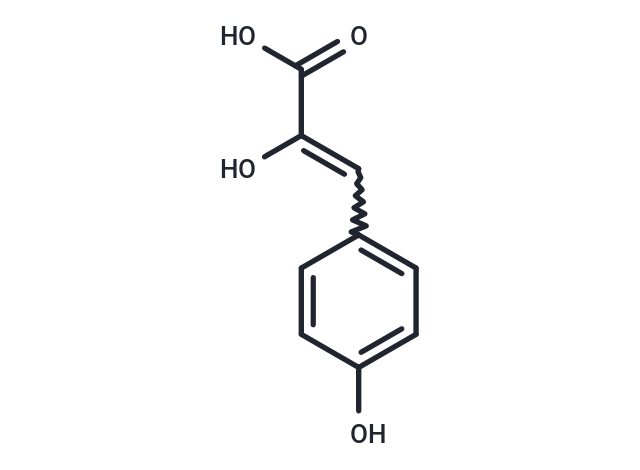 Your shopping cart is currently empty
Your shopping cart is currently empty

4-Hydroxyphenylpyruvic acid is an enzyme inhibitor.4-Hydroxyphenylpyruvic acid (4-HPPA) is a keto acid that is involved in the tyrosine catabolism pathway. It is a product of the enzyme (R)-4-hydroxyphenyllactate dehydrogenase (EC 1.1.1.222) and is formed during tyrosine metabolism. The conversion from tyrosine to 4-HPPA is catalyzed by tyrosine aminotransferase. Additionally, 4-HPPA can be converted to homogentisic acid which is one of the precursors to ochronotic pigment. The enzyme 4-hydroxyphenylpyruvic acid dioxygenase (HPD) catalyzes the reaction that converts 4-hydroxyphenylpyruvic acid to homogentisic acid. A deficiency in the catalytic activity of HPD is known to lead to tyrosinemia type III, an autosomal recessive disorder characterized by elevated levels of blood tyrosine and massive excretion of tyrosine derivatives into urine. It has been shown that hawkinsinuria, an autosomal dominant disorder characterized by the excretion of 'hawkinsin,' may also be a result of HPD deficiency . Moreover, 4-hydroxyphenylpyruvic acid is also found to be associated in phenylketonuria, which is also an inborn error of metabolism. There are two isomers of HPPA, specifically 4HPPA and 3HPPA, of which 4HPPA is the most common.

| Pack Size | Price | USA Warehouse | Global Warehouse | Quantity |
|---|---|---|---|---|
| 50 mg | $35 | In Stock | In Stock | |
| 100 mg | $50 | In Stock | In Stock | |
| 200 mg | $73 | In Stock | In Stock | |
| 1 mL x 10 mM (in DMSO) | $30 | In Stock | In Stock |
| Description | 4-Hydroxyphenylpyruvic acid is an enzyme inhibitor.4-Hydroxyphenylpyruvic acid (4-HPPA) is a keto acid that is involved in the tyrosine catabolism pathway. It is a product of the enzyme (R)-4-hydroxyphenyllactate dehydrogenase (EC 1.1.1.222) and is formed during tyrosine metabolism. The conversion from tyrosine to 4-HPPA is catalyzed by tyrosine aminotransferase. Additionally, 4-HPPA can be converted to homogentisic acid which is one of the precursors to ochronotic pigment. The enzyme 4-hydroxyphenylpyruvic acid dioxygenase (HPD) catalyzes the reaction that converts 4-hydroxyphenylpyruvic acid to homogentisic acid. A deficiency in the catalytic activity of HPD is known to lead to tyrosinemia type III, an autosomal recessive disorder characterized by elevated levels of blood tyrosine and massive excretion of tyrosine derivatives into urine. It has been shown that hawkinsinuria, an autosomal dominant disorder characterized by the excretion of 'hawkinsin,' may also be a result of HPD deficiency . Moreover, 4-hydroxyphenylpyruvic acid is also found to be associated in phenylketonuria, which is also an inborn error of metabolism. There are two isomers of HPPA, specifically 4HPPA and 3HPPA, of which 4HPPA is the most common. |
| Synonyms | 4-Hydroxyphenylpyruvic acid |
| Molecular Weight | 180.16 |
| Formula | C9H8O4 |
| Cas No. | 156-39-8 |
| Smiles | OC(=O)C(O)=CC1=CC=C(O)C=C1 |
| Relative Density. | 1.2933 g/cm3 (Estimated) |
| Storage | Powder: -20°C for 3 years | In solvent: -80°C for 1 year | Shipping with blue ice/Shipping at ambient temperature. | |||||||||||||||||||||||||||||||||||
| Solubility Information | DMSO: 158.3 mg/mL (878.66 mM), Sonication is recommended. | |||||||||||||||||||||||||||||||||||
| In Vivo Formulation | 10% DMSO+40% PEG300+5% Tween 80+45% Saline: 2 mg/mL (11.1 mM), Sonication is recommended. Please add the solvents sequentially, clarifying the solution as much as possible before adding the next one. Dissolve by heating and/or sonication if necessary. Working solution is recommended to be prepared and used immediately. The formulation provided above is for reference purposes only. In vivo formulations may vary and should be modified based on specific experimental conditions. | |||||||||||||||||||||||||||||||||||
Solution Preparation Table | ||||||||||||||||||||||||||||||||||||
DMSO
| ||||||||||||||||||||||||||||||||||||
| Size | Quantity | Unit Price | Amount | Operation |
|---|

Copyright © 2015-2025 TargetMol Chemicals Inc. All Rights Reserved.